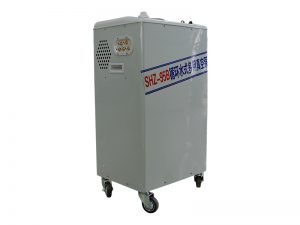[ux_image id=”24974″ height=”63%” lightbox=”true” caption=”true” image_hover=”zoom” image_hover_alt=”zoom-long”]
[gap]
A water circulating vacuum pump is a new type of multi-purpose vacuum pump taking circulating water as the working fluid and using the jet to generate the negative pressure. It can provide vacuum condition for chemical laboratories as well as supply recirculated cooling water for reaction devices. It is an ideal equipment used in universities, pharmaceuticals, food processing and other fields.
How does a Water Circulating Vacuum Pump Work?
The pump is filled with an appropriate amount of water as its working fluid. When the impeller rotates clockwise, the water is thrown around by the impeller. Due to the centrifugal force, the water forms a closed ring of approximately equal thickness depending on the shape of the pump chamber. The inner surface of the lower portion of the water ring is just tangent to the impeller hub, and the upper inner surface of the water ring is just at the tip of the blade (actually the blade has a defined insertion depth in the water ring). At this time, a crescent space is formed between the impeller hub and the water ring, and this space is divided by the impeller into a plurality of small cavities equal to the number of blades. If the lower part of the impeller is used as the starting point, then the impeller is 180 degrees before the rotation, the small cavity area is increased from small to large, and communicates with the suction port on the end face. At this time, the gas is sucked, and when the inhalation is finished, the small cavity is Isolated from the suction port; when the impeller continues to rotate, the small cavity becomes larger and smaller, so that the gas is compressed; when the small cavity communicates with the exhaust port, the gas is discharged outside the pump.

Pros and Cons of Water Circulating Vacuum Pump
Compared to other types of mechanical vacuum pumps, a water circulating vacuum pump (water ring vacuum pump) has the following advantages:
- It is easy to manufacture with a simple structure and low requirements for manufacturing accuracy.
- The structure is compact. The pump has a higher revolution, which can be directly connected to the motor without the need of a reduction gear. So it adopts a smaller size to occupy a smaller land and obtain a larger volume of gas displacement.
- The compressed gas has the basically same temperature. It means that the temperature changes little when the air is compressed.
- There is no need to lubricate the pump, and the wear is very small because there is no metal friction surface in the pump cavity. The sealing between the rotating parts and fixing parts is directly completed by water sealing.
- It inhales evenly and works stably and reliably. It is easy to operate and convenient to maintain.
However, a water circulating vacuum pump also has its disadvantages, as follows:
- Low efficiency. Generally the efficiency is about 30%, and a better one can be up to 50%.
- Low vacuum degree. Not only is it limited by the structure, but more importantly it is limited by the working fluid and saturated vapor pressure. The ultra pressure can only be from 2000Pa to 4000Pa by taking water as working fluid, while it can be up to 130Pa by taking oil as working fluid.
In conclusion, the gas compressed in the pump has the same temperature, so the flammable and explosive gas can be pumped out. Without the exhaust valve and friction surface, the dusty gas, condensable gas and gas-water mixture can be pumped out as well. With these remarkable features, it still has extensive applications even if the efficiency is low.
[title text=”Related Products” tag_name=”h2″ color=”rgb(119, 199, 239)”]
[ux_products ids=”205,203,211,13920,216″]
[title text=”Related Posts” tag_name=”h2″ color=”rgb(119, 199, 239)”]
[blog_posts style=”vertical” columns=”2″ columns__md=”1″ depth=”2″ slider_nav_style=”simple” slider_nav_position=”outside” ids=”24959,24894,24868,24887,24860,6979″ image_height=”89%” image_width=”43″]